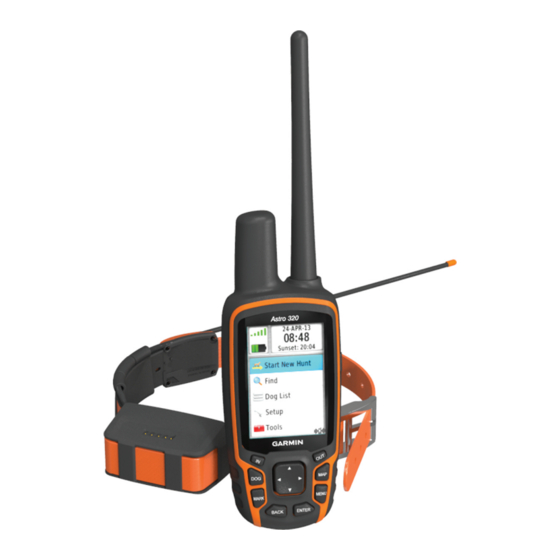Garmin Astro 320 with T5 Руководство пользователя - Страница 6
Просмотреть онлайн или скачать pdf Руководство пользователя для Средство для ухода за домашними животными Garmin Astro 320 with T5. Garmin Astro 320 with T5 22 страницы.

3
Replace the battery cover, and turn the D-ring clockwise.
4
Hold .
5
Select Setup > System > Battery Type.
6
Select Alkaline, Lithium, or Rechargeable NiMH.
Charging the Dog Collar Device
To prevent corrosion, thoroughly dry the contacts on the collar
and the surrounding area before connecting the charging clip.
You should fully charge the battery before you use the device
for the first time. Charging a fully depleted battery takes about
five hours. The device will not charge when outside the
temperature range of 32° to 104°F (0° to 40°C).
1
Snap the charging clip
2
Plug the included power cable into the mini-USB port on the
charging clip cable.
3
Plug the power cable into a power source.
The status LED is solid red when the collar is charging.
4
After the status LED turns solid green, remove the charging
clip from the collar.
Turning On the Devices
• On the handheld device, hold the power key until the
LCD display turns on.
• On the dog collar device, hold the power key until the status
LED flashes and the collar beeps.
Turning Off the Devices
• On the handheld device, hold the power key until the
LCD display turns off.
• On the dog collar device, hold the power key until the status
LED flashes and the collar beeps.
Acquiring Satellite Signals
Both the collar and handheld device must acquire satellite
signals before you put the collar on your dog. Acquiring
satellites can take a few minutes.
1
Go outdoors to an open area.
2
Turn on both devices
(Turning On the
3
Select the power key on the handheld device.
2
NOTICE
onto the device
.
Devices).
shows the GPS signal strength.
When the collar has acquired satellite signals, the status LED
flashes a double-blink or triple-blink in green.
Adjusting the Backlight Brightness
NOTE: The backlight brightness may be limited when the
battery strength is low.
Extensive use of screen backlighting can significantly reduce
battery life.
1
Select .
2
Select
to cycle through the brightness levels.
3
Select ENTER.
Fitting the Collar on Your Dog
Before you can put the collar on the dog, you must pair the
handheld device and collar
signals
(Acquiring Satellite
1
Position the collar with the VHF whip antenna pointing up,
the GPS antenna facing up, and the LEDs facing forward.
2
Place the collar around the middle of the dog's neck.
3
Tighten the strap so it is snug around the dog's neck.
NOTE: The collar should fit tightly and should not be able to
rotate or slide on the dog's neck. The dog must be able to
swallow food and water normally. You should observe your
dog's behavior to verify the collar is not too tight.
4
If the strap is too long, cut off the excess, leaving at least
3 in. (7.62 cm) to spare.
Using the On-Screen Keyboard
A keyboard appears when you enter text.
• Select , ,
, and
to select a character, and select
ENTER.
• Select
to backspace.
• Select
to shift.
• Select IN or OUT to change the character mode of the
keyboard.
• Select Done to save the text and close the keyboard.
Dog Tracking
The handheld device allows you to track your dog, using the
tracking compass or map. The map displays your location and
your dog's location and tracks. The compass pointer indicates
the direction of the dog's current location.
Tracking Your Dog on the Map
Before you can track a dog on the map, you must add them to
the handheld device
(Adding a
You can view the dog's location on the map.
(Adding a
Dog), and acquire satellite
Signals).
Dog).
Dog Tracking
